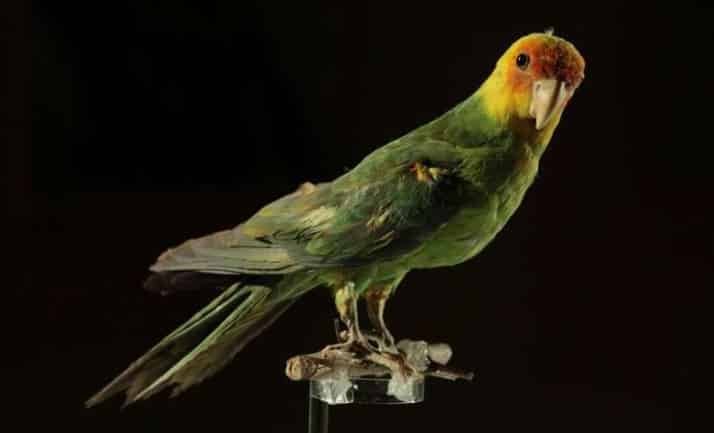
Health Editor’s Note: While I do not live in a climate where this type of parrot/parakeet would find comfortable to live in, other than in the summer months, this would have been a bird I would have welcomed into my yard. Imagine seeing the colors and hearing their voices. A species cannot withstand stresses without having horrible consequences. Humans, as they usually are, and less get read, would have been the stressors responsible for this species demise……Carol
The Extinction of This U.S. Parrot Was Quick and Driven by Humans
by Brigit Katz/Smithsonian.com
In centuries past, large flocks of noisy, brightly colored parrots squawked their way across the United States—from New England, to Florida, to eastern Colorado. The Carolina parakeet, or Conuropsis carolinensis, was the only parrot native to the eastern part of the country. But by the beginning of the 20th century, it had disappeared.
Experts believe that humans played a prominent role in the species’ extinction. The clearing of forests to make way for agricultural land destroyed the birds’ habitat and may have contributed to their loss. They were hunted for their vibrant feathers of green, yellow and red, which made a popular addition to ladies’ hats. Farmers considered them pests and killed them in large numbers; the parrots were easy targets, due to their unfortunate tendency to congregate around wounded flockmates.
But as Liz Langley reports for National Geographic, some experts have speculated that causes not directly driven by humans—like diseases spread by poultry and natural disasters that fragmented the Carolina parakeet’s habitat—may have contributed to the species’ decline. Hoping to shed new light on the issue, a team of researchers sequenced the Carolina parakeet’s genome—and found that human causes were likely the sole driver of the bird’s abrupt extinction.
To conduct their analysis, the team looked at the tibia bone and toe pads of a preserved parakeet specimen held in a private collection in Spain. Because its DNA was fragmented, the researchers also sequenced the genome of the Carolina parakeet’s closest living relative, the sun parakeet, which gave them a more complete picture of the extinct bird’s genetic profile.

Carol graduated from Riverside White Cross School of Nursing in Columbus, Ohio and received her diploma as a registered nurse. She attended Bowling Green State University where she received a Bachelor of Arts Degree in History and Literature. She attended the University of Toledo, College of Nursing, and received a Master’s of Nursing Science Degree as an Educator.
She has traveled extensively, is a photographer, and writes on medical issues. Carol has three children RJ, Katherine, and Stephen – one daughter-in-law; Katie – two granddaughters; Isabella Marianna and Zoe Olivia – and one grandson, Alexander Paul. She also shares her life with her husband Gordon Duff, many cats, and two rescues.
ATTENTION READERS
We See The World From All Sides and Want YOU To Be Fully InformedIn fact, intentional disinformation is a disgraceful scourge in media today. So to assuage any possible errant incorrect information posted herein, we strongly encourage you to seek corroboration from other non-VT sources before forming an educated opinion.
About VT - Policies & Disclosures - Comment Policy



